
Polyglucosamine – a diamond with many facets
Like a real diamond, our Polyglucosamine L112 dietary fibre comes from natural and is obtained from the chitin shells of crustaceans whose meat is used in food products. Polyglucosamine L112 is a highly multifaceted active substance with various effects on our organism.
Polyglucosamine L112 helps reduce and control body weight through its ability to bind relevant amounts of dietary fat. Oxidized fats and cholesterol can also be bound. This leads to a reduction in LDL cholesterol in the blood. In addition, the hs-CRP inflammatory parameter also drops.
Many of polyglucosamine’s positive properties lie in its nature as a dietary fibre. Dietary fibre has a positive effect on stool consistency and is excellent for increasing the diversity of the gut microbiome, thus having a positive influence on gut health. Because fibre shortens the gut transit time, it may also help improve some symptoms of diverticulitis.
Polyglucosamine from natural sources
The shells of crustaceans (Alaska snow crabs; Chionoecetes opilio) caught at sea for the food industry provide us with the material from which our active fibre polyglucosamine is produced. Chitin – the raw material – is obtained from the shells of these crustaceans and, in a specified process, is transformed into “Polyglucosamine L112″ and further activated by adding the excipients ascorbic and tartaric acid.
Only Polyglucosamine L112 is further processed, of which 1 g binds at least 680 g of fat. High-quality pharmaceutical-grade excipients are used for tabletting. Production of preliminary stages and tablets is carried out according to Certmedica’s quality management system specifications.

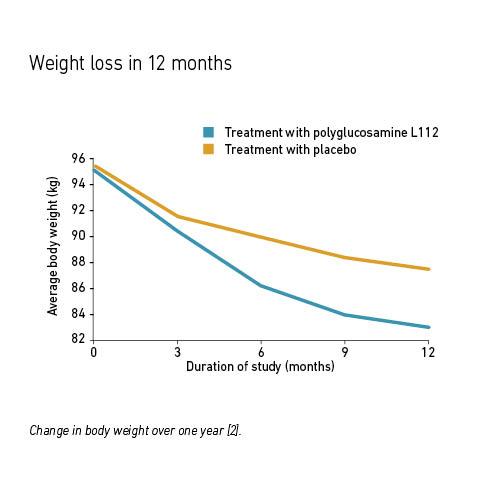
Fat binding – lose weight with polyglucosamine
Polyglucosamine L112 – thanks to its structure and very high fat binding capacity – can reduce the bioavailability of dietary lipids by up to 2/3. [1] The energy density of fat is roughly twice that of protein or carbohydrates, so reducing dietary fat intake is effective in losing and maintaining weight. This is no secret of course, but common knowledge.
Nevertheless, we have an abundant supply of food at our immediate disposal in our everyday lives, along with a large assortment of readily available convenience foods, usually containing far too much fat. No wonder many of us are becoming overweight or obese, because consistent self-control is tough for all of us at times. Polyglucosamine L112 has been shown here to reduce dietary fat intake.
A one-year study showed that adding polyglucosamine (PG) to two meals daily helped reduce weight significantly more than lifestyle changes alone.[2] All 100 participants raised their physical activity slightly and reduced their calorie intake. Half the participants received PG, the other half a placebo. Taking PG reduced body weight by 12 kg over the year on average, while participants without PG lost only 8 kg. PG was very well tolerated, with only three participants (including just one from the PG group) dropping out of the study prematurely.[2] This shows that taking PG, alongside the suggested lifestyle intervention, leads to relevant weight-loss results – without excessive stress or considerable restrictions.
Less inflammation: Reduction of the hs-CRP level
The hs-CRP level, i.e. high-sensitivity C-reactive protein, is an inflammation marker and is used, among other things, for risk assessment in cardiovascular disease. Polyglucosamine affects hs-CRP levels.
Within just three months of starting the intake of polyglucosamine (2x 2 tablets a day in addition to moderate calorie reduction and more daily exercise), the hs-CRP level can be significantly reduced. This was shown in a long-term study in 2017.[2] The hs-CRP level dropped significantly more with polyglucosamine than with a placebo.
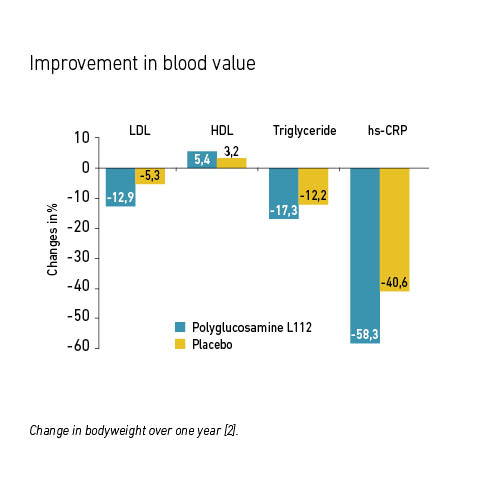
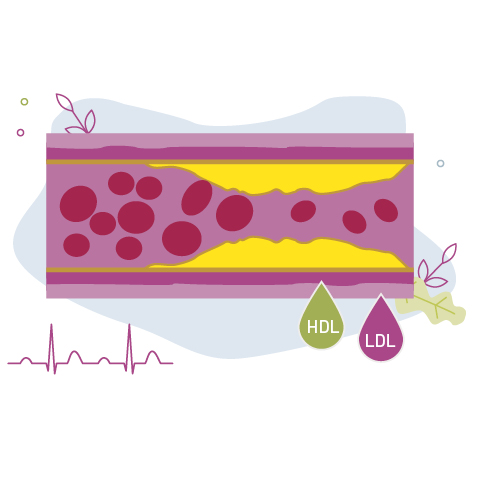
Cholesterol reduction
Many people in Germany have elevated total cholesterol levels (≥190 mg/dl women: 60.5%, men: 56.6%) [3] and this is associated with a higher risk of developing arteriosclerosis and suffering a heart attack or stroke.
A long-term clinical study showed that daily intake of polyglucosamine (PG), in addition to lifestyle intervention in the form of a change in diet and increased physical activity, also had a positive effect on blood fat levels.[2] Compared with the placebo group, both total cholesterol and LDL cholesterol levels were significantly reduced in the PG group. These positive changes were already apparent after three months in plasma levels of the PG group. The placebo group took more than half a year longer to show comparable positive changes in plasma levels.
HDL cholesterol levels also changed for the better in the PG group. Lifestyle intervention alone had no effect on HDL cholesterol levels in the placebo group. These results show that a rigorous switch to a healthier lifestyle certainly always pays off, but above all that the positive effects can be intensified and significantly accelerated by taking PG.
Polyglucosamine helps reduce triglycerides
Not only elevated cholesterol levels are widespread among adults in Germany. Blood triglycerides from dietary fats are also frequently elevated. These factors raise the risk of suffering diabetes. Combining high triglycerides with low levels of HDL cholesterol may exacerbate the development of vascular disease. Triglyceride levels can be influenced by a healthy lifestyle, however.
A long-term clinical study also showed that daily intake of polyglucosamine (2× 2 tablets a day) in addition to a change in diet and more physical exercise lowered triglyceride levels significantly more than this lifestyle change alone.[2] Daily intake of polyglucosamine also helps raise HDL cholesterol.
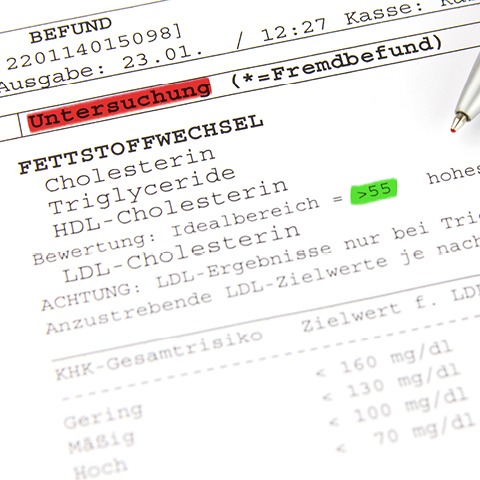

Reduce the risk of atherosclerosis
Polyglucosamine has an LDL cholesterol-reducing effect. Elevated LDL cholesterol is one of the risk factors for atherosclerosis. Atherosclerosis is a disease of arterial blood vessels caused by wear and tear, in which lipid-laden plaque in the blood vessel wall (in the tunica intima to be more precise) gradually and progressively constricts the blood flow in the vessel. This can develop into complete occlusion of the arteries, which then leads to infarction. Or the plaque ripping up and detaching can also cause blood clots. Depending on which blood vessels are affected, this can have various consequences, such as heart attack or stroke.
Atherosclerosis (hardening of arteries due to plaque build-up) initially causes no symptoms, so it often goes unnoticed for a long time. Preventive measures taken in good time can significantly reduce risk. These include reducing known risk factors for atherosclerosis, such as blood pressure control, lifestyle choices and lowering LDL.
The fact that there is a relationship between the amount of LDL cholesterol and the increase in the risk of atherosclerosis can be seen from the example of hereditary hypercholesterolemia. LDL cholesterol is significantly above the normal level for genetic reasons among people with this condition, and this is associated with a significantly higher risk of heart disease.
Many randomised clinical trials of drug-mediated lowering of cholesterol levels have shown that reducing LDL cholesterol levels reduces the risk of cardiovascular events including heart attacks or strokes. Further progression of atherosclerotic plaque formation is also slowed down by lowering LDL cholesterol and may even be stopped completely.
Promote gut health with fibre
Polyglucosamine is a high-quality dietary fibre because it cannot be utilized by the human body. Our diet in general, and the fibre content of our food in particular, has an impact on the composition and diversity of our gut microbiome. So what we eat changes the bacteria that perform important tasks in our gut, for example in digestion and immune defence.
There are very many different types of bacteria and other micro-organisms to be found there. How many different species are present in our gut really does matter, as there is evidence that low diversity is associated with various diseases. A high-fibre diet (in combination with lower levels of animal fats and proteins) increases the number of different bacterial species [4]. A review article supports a possible link between polyglucosamines and an improved microbial environment in the gut [5].
One of the features of dietary fibre is that it can have a positive effect on gut health, it has a protective effect on diverticulitis, for example. A three-month study showed that taking 3 g of polyglucosamine a day significantly reduced the incidence of symptoms associated with diverticulitis [6]. Patients taking polyglucosamine also experienced significantly less occult bleeding in the digestive tract after just one month. In addition, the hs-CRP level – an inflammatory parameter – was reduced significantly more than in the control group [6].
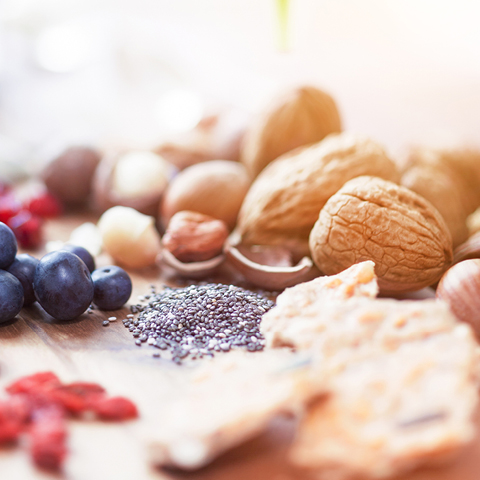
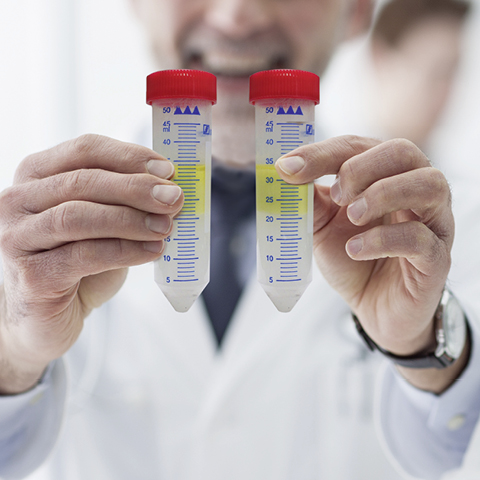
Quality and Safety
We are experts in polyglucosamine with over 20 years of experience in slimming products. At the same time, we keep a watchful eye on the future.
The quality of our products is our main factor for success. Only with high quality products can we survive on the market and be your valued weight-loss and health partner. We control our active dietary fibre according to the strict requirements of medical device legislation (EU 2017/745, the German medical devices implementation act (MPDG), etc.), starting with the extraction of the raw material through to sales.
Our product is also manufactured according to the stringent rules of our certified quality management system.
How can polyglucosamine bind so much fat?
In the acid milieu of the stomach, Polyglucosamine L112 is protonated at the free amino groups producing positively charged amino groups (-NH3+). The dietary fat absorbed is already split in the stomach to a minor extent by lipases and to a greater extent by the pancreatic lipases into glyceride and free fatty acids. The free fatty acids are primarily bound through ionic bonds between the negatively charged carboxyl groups of the fatty acids (-C00‾) and the positive charges of Polyglucosamine L112. At the pH values in the upper digestive tract, a gel structure forms which, because of its lipophilic (high affinity for lipids) character, can bind other lipophilic substances such as cholesterol and neutral fats. The absorption of fats from food in the gut is reduced as a result
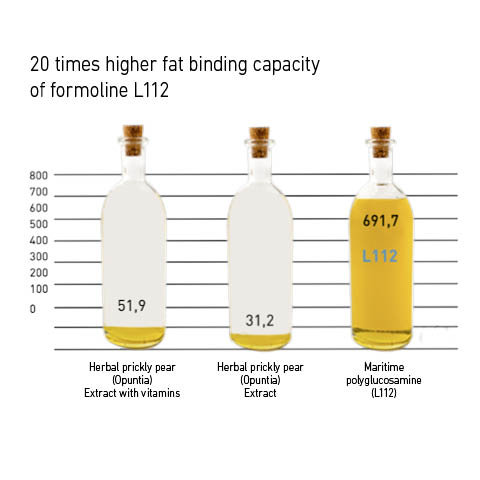
Sources
1 Cnubben N. H., Tel, S. L., Hemmes, M. A., Langenkamp-Brand, A., Grossouw, D., Jansen, H. T., & de Bie, B. T. (2016). A single oral dose of a polyglucosamine influences the bioavailability of [9-(14)C]-Oleic acid in adult female Gottingen minipigs. BMC Obes, 3, 18. doi:10.1186/s40608-016-0096-2
2 Cornelli, U., Belcaro, G., Recchia, M., & D’Orazio, N. (2017). Long-Term Treatment of Overweight and Obesity with Polyglucosamine (PG L112): Randomized Study Compared with Placebo in Subjects after Caloric Restriction. Curr Dev Nutr, 1(10), e000919. doi:10.3945/cdn.117.000919
3 Scheidt-Nave, C., Du, Y., Knopf, H., Schienkiewitz, A., Ziese, T., Nowossadeck, E., . . . Busch, M. A. (2013). [Prevalence of dyslipidemia among adults in Germany: results of the German Health Interview and Examination Survey for Adults (DEGS 1)]. Bundesgesundheitsblatt Gesundheitsforschung Gesundheitsschutz, 56(5-6), 661-667. doi:10.1007/s00103-013-1670-0
4 Simpson, H. L., & Campbell, B. J. (2015). Review article: dietary fibre-microbiota interactions. Aliment Pharmacol Ther, 42(2), 158-179. doi:10.1111/apt.13248
5 Yan, Chen; Zhang, Cuili; Cao, Xuejiao; Feng, Bin; Li, Xinli; Intestinal Population in host with metabolic Syndrome during administration of chitosan and its derivatives. Molecules 2020 Dec 11; 25(24):5857
6 Belcaro G, Cornelli U. Occult Obscure Gastrointestinal Bleeding (OGIB) in Colonic Diverticulitis using Polyglucosamine: A Registry Study Following a Standard Management Protocol. Surg Res. 2020; 2(1): 1-8

